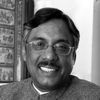I write this on the eve of the prana pratishtha of Ram Lalla in the newly built, grand temple in Ayodhya. It is a joyous occasion not only for Hindus but many Indians.
Hinduism, or sanatana dharma as it is also called, is a complex corpus of thought. The other day, I saw a light-hearted post on social media of Lord Krishna as a child, asking: 'When will I get the same attention?'. To be sure, such distinctions in Hinduism are quite irrelevant. Krishna, like Ram, is also an avatar of Vishnu, and so at the ontological level, there is no difference between them.
However, the description of their incarnational characters is substantially different. Ram is Maryada Purushottam and Krishna is Leela Purushottam. Ram, apart from being the role model for the ideal human being, stands for order and stability, equilibrium and equipoise in the working of the cosmos, where choices are determined not by whim but by the conscious thought of what is right, even when other choices could have been made.
Krishna, on the other hand, is the human incarnation of the playful, whimsy divine who is unconventional, non-conformist, lovingly mischievous and the very embodiment of God delightfully enjoying himself for no other reason than the sheer joy of it. Thus, while Ram is the dutiful son, the caring brother, the devoted husband and the steadfast family man, Krishna is the adorable child who steals butter, the precocious adolescent who flirts with the gopis the irresistible flute-playing lover who frolics with women in Vrindavan on the banks of the Yamuna, and the incorrigibly unfaithful companion to his beloved and supreme love, Radha. And yet, in delivering the doctrine of nishkama karma in the Bhagwad Gita, he is the Saviour Himself.
There can be no two more contrasting profiles of arguably the two most popular gods in Hinduism, at least in the Vaishnav tradition. Why did the Hindu mind create these two beloved deities in such drastically different ways? Why did it not, for purposes of devotion, choose a monochromatic representation of divinity rather than this explosive kaleidoscope of differing attributes? The answer provides the key to the cerebral complexity of Hinduism, and its fearless resolve to uninhibitedly plumb the unusual in order to provide a glimpse of the infinite spectrum of divinity.
If the Ultimate is beyond definition, it cannot be portrayed in simplistic and predictable ways. Maryada Purushottam Ram is one aspect of the grandeur of the universe; Leela Purushottam Krishna is another aspect of the playful energy of the cosmos. Both represent facets of the seamless benediction of Ishvara and the omniscience of the all-pervasive nirguna (the eternal omnipresent divine) consciousness of Brahman.
In fact, especially during the six hundred years long Bhakti movement (1200-1800 CE), the earlier schisms between the different principal deities of Hinduism—most prominently between the Shaivite and Vaishnav schools—were bridged, since the devotees were seeking direct communion with the chidanand rupam, and bliss and awareness, of the supreme consciousness.
Tulsidas was himself a poet of the Bhakti school. While for most of the other bhakti poets—Chandidas, Vidyapati, Bihari, Surdas and many others—Krishna was the subject of devotion, for Tulsi it was Ram. In South India, Shiva was the idol for the bhakti outpouring of Basavanna, Allama Prabhu, Antaal and the Nayanars. But Tulsi himself becomes a bridge between the Shaivite and Vaishnav sects. In the Ramcharitmanas, it is Ram who pays the highest tribute to Shiva, in one of the most famous compositions of the Manas:
Namamishamishan nirvanarupam
Vibhum byakamam Brahma vedasvarupam
Nijam nirgunam nirvikalpam niriham
Chidakashamaakashavasam bhaje hum
I adore You, Ruler of the whole universe
Eternal bliss personified, the all-pervading Brahman
I worship Lord Shiva, shining in His own glory
Devoid of material attributes, undifferentiated, desireless
All-pervading consciousness, pure awareness enveloped in space
And Shiva, on his part, tells Parvati who Ram really is:
Harasha bishaada gyana agyana
Jiva dharma ahamiti abhimana
Ram Brahman byapaka jaga jaana
Paramanand paresha purana
Joy and grief, knowledge and ignorance, egoism and pride
These are the characteristics of a finite being
Shri Ram is the all-pervading Brahman
The highest Lord and the most ancient Being
The whole world knows this
As the much-awaited prana pratishtha is concluded, it is always important to understand that Shri Ram, as the incarnate symbol of Brahman, that is in you and me, and all animate and inanimate things, is the symbol of unity not division, of harmony, not acrimony. That is, indeed, the civilizational ethos of India. That is why, the great saint-poet Kabir (1440-1518 CE), in the spirit of Vedantic universality, writes:
If God be within the mosque, then to whom does the world belong?
If Ram be within the image which you find upon your pilgrimage
Then who he is there to know what happens without?
Hari is in the East, Allah in the West,
Look within your heart, for there you will find both Karim and Ram
All the men and women of the world are His loving forms
Kabir is the child of Allah and of Ram: He is my Guru, He is my Pir
(Translation: Rabindranath Tagore, One Hundred Poems of Kabir)
Pavan K Varma is author, diplomat, and former Member of Parliament (Rajya Sabha). Just Like That is a weekly column where Varma shares nuggets from the world of history, culture, literature, and personal reminiscences with HT Premium readers. The views expressed are personal





















 Toi Staff
Toi Staff Gideon Levy
Gideon Levy Belen Fernandez
Belen Fernandez Andrew Mitrovica
Andrew Mitrovica Mort Laitner
Mort Laitner Rami G Khouri
Rami G Khouri Ali Fathollah-Nejad
Ali Fathollah-Nejad Nikkei Editorial
Nikkei Editorial
